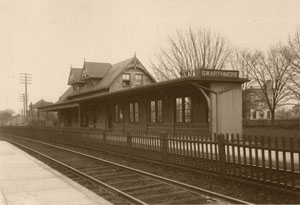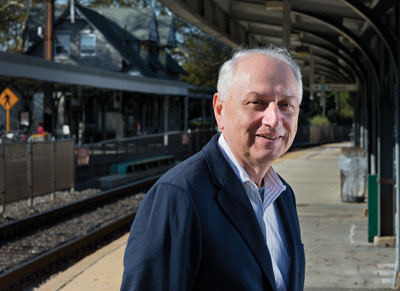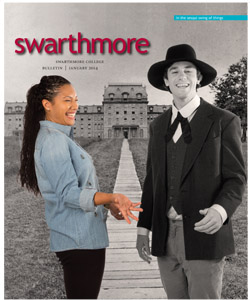A Railroad Runs Through It
The train was important to Swarthmore’s founding and still is today

The depot with the borough of Swarthmore in the background, circa 1910.
Few institutions of higher learning are bisected by a major highway. Dickinson College and James Madison University come to mind. But a railroad running through the campus proper? Perhaps only at Swarthmore. At least that’s what Jim Bock ’90, vice president and dean of admissions, speculates.
A peppy native Texan with an easy smile, Bock proudly trots out this notable feature during information sessions with prospective students and parents on the third floor of Parrish Hall or during his far-flung travels, which take him around the world to find students who are the very best fit for the Swarthmore experience.
At a recent group session, he asked parents and prospects what they knew about the College. One response: “This place is isolated.”
“I said, ‘Let’s explore that,’ and I started with the train,” Bock explains.
Many current students, in fact, claim that a key factor in making the match with Swarthmore is the train’s proximity. Those who hunger for a hit of the urban experience can reach Philadelphia in just 20 minutes via the Southeastern Pennsylvania Transportation Authority (SEPTA).
The rail connecting city and what was once country is, in fact, the reason Swarthmore College resides where it does today. Back in the 1860s, when the Hicksite Quakers were casting about for a location for their future college, they narrowed their choices to three Philadelphia-area sites, all with the same prerequisite—a nearby rail depot. Rather than Wissahickon in Montgomery County or the Radnor Farm in Delaware County, they chose Westdale, a rural neighborhood named for the local painter Benjamin West, and later renamed for the College.
“Almost everything we take for granted living and working in Swarthmore—the layout of the road system, the very location of the College, the affluence that allowed it and the region to develop—can be traced to the influence of just one privately held corporation, the mammoth Pennsylvania Railroad,” explains Frank Moscatelli, a physics professor who is a weekend tourist-train conductor (see Page 18 for details). Not only was the Pennsylvania Railroad the largest in the world in 1900, but its budget was bigger than the federal government’s, he stresses.
While serving on the College’s sesquicentennial committee last year, Moscatelli, the Edward Hicks Magill Professor of Mathematics and Natural Sciences, delved into the historic connection between the College and railroad. His research led to a half-hour talk last February for fellow faculty members. Performing a reverse striptease—slowly donning pieces of his conductor uniform (tie, vest, jacket, and conductor’s cap)—Moscatelli showed PowerPoint slides of the depot at the foot of the College hill.
From the 1880s, he displayed a bearded College grounds worker with a horse and wagon and two male students with their baggage, setting out for Magill Walk. Other images showed the depot in the early 1900s, 1930s, and into the 1940s, when heavy-duty icons of the American streamlined design whistled through town and campus.

Physicist and train buff Frank Moscatelli stops by the Swarthmore depot. He researched the connections between the train line and the College. Photo by Laurence Kesterson
He also touched on the importance of the railroad to African-American history. “The railroads were the first major employers of recently freed slaves,” he says. While the Underground Railroad, a network of secret routes and safe houses used by enslaved blacks seeking freedom, is usually not associated with real train tracks, it was an actual rail line between Lancaster and Philadelphia (now part of Amtrak’s Keystone Corridor). In specially designed boxcars, slaves traveled the 70-mile stretch, Moscatelli says, referencing a 2010 USA Today article on the topic. “You don’t think of it as an actual physical place, but it was.”
Moscatelli also mentions a local event that sparked a famous court case involving the right of blacks to ride in the same train compartment as whites. The forcible expulsion of a black teacher, Mary Miles, occurred in 1867 on the line that ran through Swarthmore (see Page 16 for details).
The railroad’s role in emancipating, rather than evicting, women also was a highlight of his research. Not only could the female members of the Board, of which 50 percent were women, travel to the College in what was then rural territory, but they could attend women’s suffrage meetings by rail. “They were liberated from the difficulty of traveling by stagecoach,” says Moscatelli.
Showing a slide of an early icon of marketing, Phoebe Snow, standing on a train platform decked out in spotless white, from bonnet to ground-grazing full skirt, he explains that this image was from an ad campaign designed to put women at ease about train travel. Phoebe was the Betty Crocker of her day, appearing in ad after ad for the Lackawanna Railroad. He also exhibits a sign instructing gamblers and the not-so-white-as-snow—“fancy women”—to sign up with the conductor upon boarding the train. “In all my time as a conductor, I never had to sign up fancy women,” says Moscatelli with a shake of his head.
The Pennsylvania Railroad has been defunct for nearly 40 years, with part of its area served by Amtrak, the other by Norfolk Southern. “Its influence on rail travel in the Northeast—from Amtrak service between Washington and New York, to freight carrier and even commuter rail—can’t be overestimated,” says Moscatelli. Nor can be the train’s influence on Swarthmore.
“The College is here because the railroad is here,” he says. “Because of the railroad, the College is in the suburbs now.”
 Email This Page
Email This Page